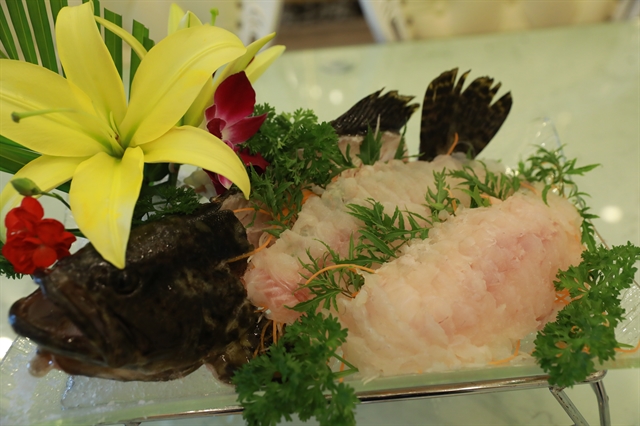
The Thanh Hóa style gỏi cá, or fresh garupa fish on an ice bed. — VNS Photo Trương Vị
Nguyễn Mỹ Hà
Making sauces to accompany food is a challenge for any chef and the world of sauces can be a jungle that novice cooks falter in.
Vietnamese dipping sauces could be categorised into a mixture of salt-based, fish sauce or soy sauce-based and more sophisticated sauces like gravy that must be simmered for a long time and blended to make a fine dipping mixture.
The basic family dipping sauce that most people learn first is to add sugar and lemon to fish sauce for summer boiled morning glory dipping. To alter the sour ingredients, you can replace with boiled dracontomelon, or tamarind.
The boiled morning glory must be dipped in mixed fish sauce or whole bean soy paste. The best soy paste comes from Bần Village in Hưng Yên Province, some 60km east of Hà Nội.
Boiled pork belly slices can be dipped in normal fish sauce. But to enhance the flavour, they must be dipped in shrimp paste, with sugar and lemon or kumquat juice. The shrimp paste exudes a strong smell, but if you have it in an open space, like a garden or patio or the chilly weather of winter, the good flavour shall be enhanced and the odour reduced.
During a meal, with shrimp paste dipping sauce sits on the table, all other sauces pale in comparison next to the imposing presence and commanding taste of the shrimp paste flavour.
In a bigger meal where you have many dishes with accompanying sauces, dip things in the shrimp paste last, because, after that, you won't want to try other dishes.
Things to be dipped in shrimp paste vary from fresh or fried tofu, boiled pork or vegetables with herbs and cucumber. But the most famous dish that goes with shrimp paste is chả cá, or Hà Nội style grilled fish.
The shrimp paste can be used with most popular northern dishes, but some of the best paste comes from the central coastal province of Thanh Hóa.
Thanh Hóa has also its own delicacy of chẻo, made from the skin and bones and fins of fresh fish. The fresh fish, or gỏi cá, is the province's answer to the world-famous sashimi of Japan. While the lean fillet gets cut into thin slices, the skins and bones must be cooked on a low flame, simmered for several hours with curcumin, galangal and seasoned to taste. It then gets blended to make a smooth gravy.
When served, you need to make a funnel with a green leaf, add a spoonful of sauce, then a red slice of hot chilli and a slice of fresh fish fillet topped with another fragrant herb.
From Thanh Hóa down to the south, the coastal fishing communities make their own signature fish and shrimp sauces.
The marshland and swamps of Huế provide six different kinds of sauces, but the most famous are anchovy sauce, tiny shrimp sauce and sour big shrimp sauce.
These sauces all go with boiled pork with lots of different fresh herbs and green fruit pickles marinated in the sauces.
The sour shrimp sauce has become so popular that many now think it originates from Huế, but in fact, Queen Từ Dũ, mother of King Tự Đức (1829-1883), and the sauce were from the land of Gò Công in the south near the Tiền Giang River. The queen missed her home food so much, she ordered that the finely sieved shrimp meat from her hometown be transported to Huế.
She then created the sour shrimp sauce from the locally caught shrimps of Tam Giang lagoon.
Quảng Nam Province also has its own variety of fish sauces. Anchovy pickles are most famous and they can be had with fresh noodles in bún mắm or rice crackers with fresh pancakes dipped in the sauce with fresh herbs and sour and acrid fresh fruit slices.
The symphony of fish sauce must be the Mekong Delta hotpot, where a mixture of different marinated sauces made from three types of fish are sieved to omit the bones. The stock is then cooked into the most flavourful hotpot you can imagine. Fresh vegetables, young bananas, lily buds, bitter gourds and bitter vegetables as well as assorted meats and seafood get dipped and cooked in the slotted ladle.
This delicacy has travelled north to become beloved in the restaurants in and around Hà Nội.
Truly, the art and craft of making marinated aqua products makes a culinary quest in and around Việt Nam so exciting and full of surprises. VNS
OVietnam